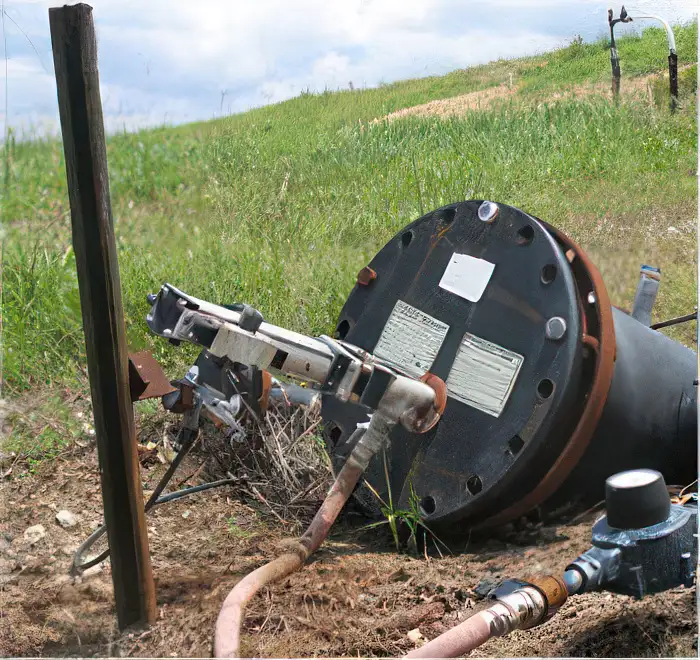The introduction of a gas system more than five years ago tested every experience the manager and the regional engineer held about landfill dynamics and leachate pumping. Although contrary to the "science," high dynamic head began to tax the leachate collection system, and liquids began behaving and moving in unexpected ways. High-flow electric submersible pumps began failing, victims of two forces — a "crusty crud" in the leachate that fouled the pumps’ motors, and leachate wells that seemed to be drying out, which burned up the exposed submersibles.
The engineer reasoned that if the gas-extraction wells were moving liquids first, there would not be much liquid left for leachate wells in some area of the landfill. Yet when submersibles were pulled, liquids again appeared in the leachate wells. "In the beginning, we tried to fix things in standard ways but the problems multiplied," the engineer said. "Liquids were moving in opposite directions from what we expected."
"The electric pumps were breaking down," the manager said. "They required lots of effort just to keep going." Plus the electrics were expensive to run, their motors were good only to 105° F., and there were transducer issues in the hot sun. The two pros were stumped.
Solution
Blackhawk was no stranger to the landfill. Blackhawk representatives had been calling on the site for several years, offering a low-flow, high-efficiency pump built to withstand the harsh, hot environment.
The patented Blackhawk pump positions the pneumatic motor above and away from the wellhead, far from the leachate. The positive-displacement pumps, unaffected by depth or vacuum, promised to be easily installed and maintained.
Like the electric submersibles, they could be installed as side-slope risers, and had the added attributes of handling high heat, solids and corrosives.
But the engineer was hesitant. "I thought the flow was too low. That was my mindset for years. My thinking was that we needed a higher flow to handle the head. The higher rates of another pump gave me more confidence," the engineer said. "But the high-flow pumps didn’t work! We were reaching a point of diminishing returns with the electric submersibles. They didn’t work well, they crusted up, and there were issues with electricity, including the cost."
Blackhawk suggested a rugged pneumatic powered by compressed air, which would fit onto a well casing of 3 inches or greater, and would remove liquids at a controlled, fully adjustable rate to the bottom of the sump, but would not burn up. The pump also would work well in the side-slope riser applications that the landfill needed. "I just wanted a pump that runs and works," the engineer said. "So we tried Blackhawk."
Result
Blackhawk — right pump, easy installation, less-frequent maintenance
The Blackhawk Tridents proved to be the right pump for the job. "After chasing my tail for years, I realized I was wrong," the engineer said. Despite the high head, a low-flow pump that worked continuously proved to be what was needed. The side-slope risers were running efficiently at 60-65 psi.
Installation was easy. "In fact, we did it ourselves and eliminated contractor costs," the gas manager said. "The units are modular and pretty simple." Maintenance, too, has been easy and inexpensive. "We’ve experienced maintenance intervals of six months, vs. one month for the others," he said. "That speaks for itself."
The landfill owners are sticklers for compliance and verification. "And once you get a new cell floored in, given our waste stream, you don’t know exactly what’s going on down there," the manager said. "Blackhawk makes it easy."
What is the situation today? "The heavy-duty pneumatics are steady performers and are here for the long haul," the engineer said. "By running steadily, they reached a point where they caught up and now they’re keeping up — a thousand gallons a day. We entered a new cell recently, and we can see they’re keeping up. Blackhawk just keeps going and going and going."
Pump and Well Specs
| Model: |
Blackhawk heavy pneumatic; slide-slope risers |
| Application: |
Leachate pumping — hot, crusty |
| Side-slope riser length: |
30 — 80 feet |
| Well diameter: |
18 inches |
| Casing construction: |
HDPE |
| Materials pumped: |
Highly variable leachate |
| Total dynamic head: |
400 feet |
| Flow rate: |
1,000 gdp |
The gas situation has become even more pronounced recently. Gas generation exceeded estimates, and the landfill is seeing gas generation quickly in new areas. And with the gas comes the challenges in leachate pumping. Even in new cells, issues are developing within months as new pathways are created. "And we’re mindful of the next level of compliance," the engineer said.
The irony for this site, the manager says, is that even though high quantities of gas are being generated, it is being flared off — at least until gas prices rise. "When the costs of building a pipeline are justified, we’ll be ready with great supply."
Landfill Facts
| Size: |
207 acres |
| Type: |
Subtitle D linear system |
| Capacity |
41 million cubic yards |
| Materials accepted: |
Heterogeneous — Trash, construction debris, sludges, ash, bio solids, etc. |
| Characteristics: |
harsh, hot, highly volatile |
| Opened: |
Mid 1980s, expanded mid 2000s by 140 acres |
| Life Expectancy: |
40 years; 25 percent full |
| Tons annually: |
800,000 |
| Area Served: |
Metro and rural areas in Southern State |
